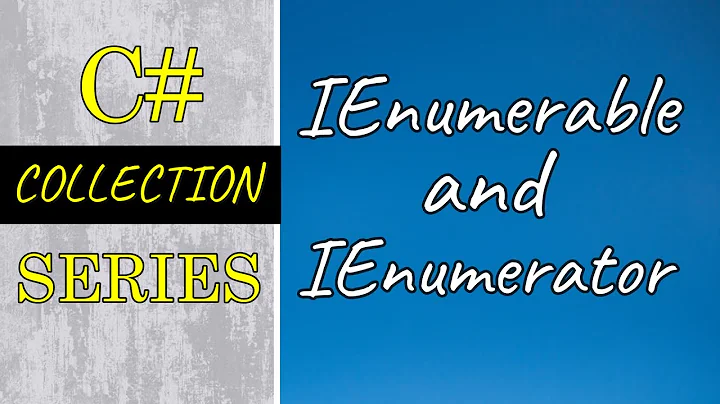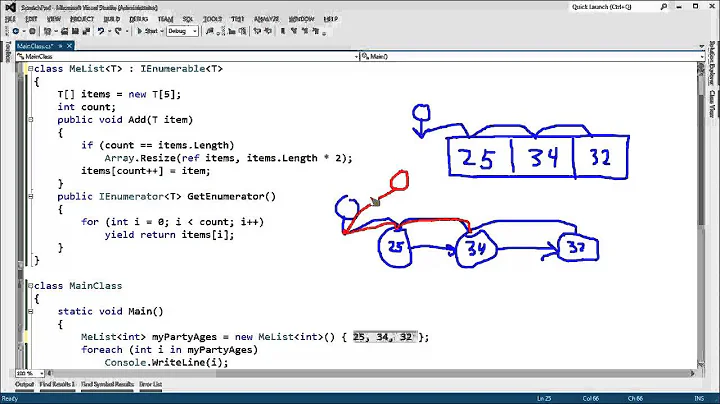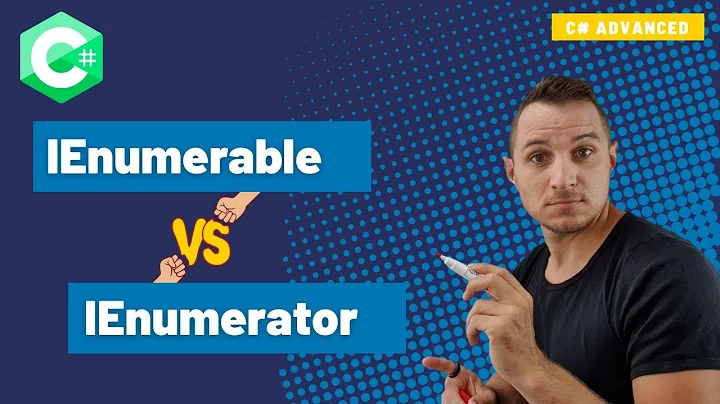IEnumerable , IEnumerator vs foreach, when to use what
Solution 1
foreach uses the interfaces in many cases. You need the interfaces if you want to implement a sequence which foreach can then use. (Iterator blocks usually make this implementation task very simple though.)
However, just occasionally it can be useful to use the iterators directly. A good example is when trying to "pair up" two different sequences. For example, suppose you receive two sequences - one of names, one of ages, and you want to print the two together. You might write:
static void PrintNamesAndAges(IEnumerable<string> names, IEnumerable<int> ages)
{
using (IEnumerator<int> ageIterator = ages.GetEnumerator())
{
foreach (string name in names)
{
if (!ageIterator.MoveNext())
{
throw new ArgumentException("Not enough ages");
}
Console.WriteLine("{0} is {1} years old", name, ageIterator.Current);
}
if (ageIterator.MoveNext())
{
throw new ArgumentException("Not enough names");
}
}
}
Likewise it can be useful to use the iterator if you want to treat (say) the first item differently to the rest:
public T Max<T>(IEnumerable<T> items)
{
Comparer<T> comparer = Comparer<T>.Default;
using (IEnumerator<T> iterator = items.GetEnumerator())
{
if (!iterator.MoveNext())
{
throw new InvalidOperationException("No elements");
}
T currentMax = iterator.Current;
// Now we've got an initial value, loop over the rest
while (iterator.MoveNext())
{
T candidate = iterator.Current;
if (comparer.Compare(candidate, currentMax) > 0)
{
currentMax = candidate;
}
}
return currentMax;
}
}
Now, if you're interested in the difference between IEnumerator<T> and IEnumerable<T>, you might want to think of it in database terms: think of IEnumerable<T> as a table, and IEnumerator<T> as a cursor. You can ask a table to give you a new cursor, and you can have multiple cursors over the same table at the same time.
It can take a while to really grok this difference, but just remembering that a list (or array, or whatever) doesn't have any concept of "where you are in the list" but an iterator over that list/array/whatever does have that bit of state is helpful.
Solution 2
What Jon said.
-
IEnumerableorIEnumerable<T>: by implementing this an object states that it can give you an iterator that you can use to traverse over the sequence/collection/set -
IEnumeratororIEnumerator<T>: if you call the GetEnumerator method defined in the previous interface, you get an iterator object as an IEnumerator reference. This enables you to call MoveNext() and get the Current object. -
foreach: is a C# construct/facade in a sense in that you don't need to know how it works under the hood. It internally gets the iterator and calls the right methods for you to concentrate on what you want to do with each item (the contents of the foreach block). Most of the time, you'd just need foreach unless you're implementing your own type or custom iteration, in which case you'd need to get to know the first 2 interfaces.
Solution 3
Bear in mind that you don't have to implement IEnumerator and varients thereof to use foreach - IIRC, all it needs is a GetEnumerator() method that returns an object that has a MoveNext() method returning a bool, and a Current property returning an object. You don't need to use IEnumerator and IEnumerable, although it generally is a very good idea to do so. See here for more information.
Related videos on Youtube
Comments
-
Leon Lang over 3 years
I was going through IEnumerable and IEnumerator , but could not get one point clearly..if we have foreach, then why do we need this two interfaces? Is there any scenario where we have to use interfaces.If yes, then can somebody explain with an example. Any suggestions and remarks are welcome. Thanks.
-
Leon Lang almost 15 yearsThanks Jon for all ur help.I got it now and will study more to make it clear. Also I find following link very useful: stackoverflow.com/questions/558304/…
-
Leon Lang almost 15 yearsThanks Gishu for making it more clear to me. also I find this link very useful: stackoverflow.com/questions/558304/…
-
Steve Cooper almost 15 yearsIt's a strange old beast, that one -- you can just implement the two methods. The big problem with doing that is that the type system doesn't know the thing is enumerable, so I imagine you'd have trouble using it with, say, Linq to Objects.
-
Sam Saffron almost 15 yearsThis is an example of where you are stuck using IEnumerator just to stay efficient. stackoverflow.com/questions/1018407/…
-
Eric Lippert almost 15 yearsYes, it is odd. The reason we support that feature is so that you can write a collection of integers in C# 1.0 and enumerate them without boxing. Now that we have IE<T>, there is no need for the "pattern" approach any more.
-
supercat about 13 years@Eric Lippert: There's another advantage to that feature: it makes it possible to avoid heap allocations for struct enumerators, though I would suggest that classes whose GetEnumerator methods return a struct should have IEnumerable.GetEnumerator methods which return classes.
-
Imran Amjad almost 12 years@Jon Skeet I really liked the way you coded Max<T> method. I've one question. you used using construct with IEnumberator. I know using disposes what comes inside it (). Why did you use it on IEnumberator?
-
Jon Skeet almost 12 years@ImranAmjad:
IEnumerator<T>implementsIDisposable, so you're meant to callDisposewhen you're finished with it. In particular, if the sequence you're using is generated from an iterator block, that allowsfinallyblocks to be executed - so resources can be released from there. -
Imran Amjad almost 12 yearsOh i see the difference. IEnumerator doesn't implement IDisposible but IEnumberator<T> does. That's good to know. Also if we implement IEnumerator<T> we have to implement Dispose method. As you said, if sequence is generated, it has to be disposed off. Thanks a lot!
-
Jon Skeet almost 12 years@ImranAmjad: The fact that
IEnumeratordoesn't implementIDisposableis really just a mistake. Since C# 1.2 (in .NET 1.1) theforeachloop has always dispose of iterators that implementIDisposable. -
Nick Patterson over 3 yearsFirst element: Select(val, index) will return the index of the current element. With a simple extension method on Enumerable, you can write:
foreach(var item in myList.SelectWithIndex()){ if (item.index == 0){Console.WriteLine(item.val.ToString());} else {...}}






